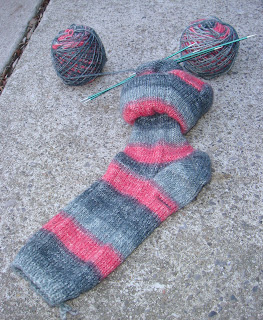As I mentioned earlier, some of our very best friends welcomed a baby this week - little Sophie.
We drove out to meet her today. She's a little sweetie, and we're honoured to be considered auntie and uncle.
Since they told us they were expecting, I had been thinking of what to make. Her Dad was Norman's best man, and they have been friends for a very very long time. I knew this baby would need something special.
So I got my designing hat on, and came up with a blankie.
The concept isn't new, but as always, I've added my own twist. It's a giant mitred square, made with seven different balls of Mission Falls 1824 Cotton. It's machine washable, and apparently exactly the right size for tucking into the car seat and moses basket.
I had much fun with the colours. If you're using multiple colours, the rule of thumb is to use an odd number. Somehow looks better that way.
So I chose 7 colours: I started with a pink in case the baby was a girl, and a blue in case the baby was a boy. And then I added purple for Heather, Sophie's mum. Green for George, her dad. George not only begins with G like green, but he is an environment scientist. The orange is for their cat, Fig; the black is for their dog, Zevon. And the last colour... well, as I mentioned above, it's a reference to an amusing situation we shared with them. In this case, it's about that time their cat peed in our car.
And so was born an idea. The colour-your-own-story baby blanket.
To start, there should be a shade of pink and a shade of blue. To cover all the bases.
And there should be a colour for each parent - colours that connects to their names, or their favourite colours.
And then colours for any siblings (human or animal). Either the colours of the pets, or favourite colours of the siblings.
And then a colour that connects the knitter to the parents. And then get knitting!
Colour-Your-Own-Story Baby Blanket Materials
Materials7 different balls
Mission Falls 1824 Cotton (or other washable worsted/aran weight yarn; the Mission Falls 1824 wool would work just as well)
-a colour each for the two parents
-a shade of blue (bright or subtle, your choice) in case baby is a boy
-a shade of pink (bright or subtle, your choice) in case baby is a girl
-2 colours to represent the family welcoming the baby - colours of the pets, favourite colours of the siblings, the colours of the university at which the couple met
-and a colour to tell a story - are these your favourite friends to drink red wine with? use red! white wine? - use white!; do you love to camp with these friends - then how about the colour of the tent?; the colour of the logo of the company you were working at when you met? - have fun and be creative!
1 24 inch/60 cm 4.5mm circular needle
Gauge:18 sts per 4 inches on garter stitch on 4.5mm needles; it's not critical to match size, it's more about getting a nice fabric with a bit of drape
Finished size:approximately 66 cm/26 inches square
Method:With the first colour, cast on 3 sts.
Row 1 (RS): K1, m1, place marker, k1, m1, k1.
I like to use Elizabeth Zimmerman's backwards loop make 1 increase here - just make a backwards loop and put it on the right needle.
Row 2 and all following WS rows: Knit all sts.
Row 3 and all following RS rows: K to marker, m1, slip marker, k1, m1, knit to end.
Repeat rows 2 & 3.
Change colours as you near the end of the ball at the start of a RS row. As the rows get longer, the stripes will get shorter - you'll get fewer rows per stripe. For the later balls, you may only get 24 or 26 rows. As you come close to the end of the ball, you can figure out if you've got enough left by measuring the yarn against the blanket. Each row needs about three times its width in yarn, so if you've got at least 12 times the width of one of the sides of the blanket, you have enough for another pair of rows. When in doubt, just change yarns.
Keep going until all 7 colours are used up. Cast off loosely on the WS.
Give it a good machine wash before you hand it over - to soften it up and get it ready for baby.


 Not only is it possible to knit two socks at the same time, one inside the other, but we also have proven conclusively that it can be fun.
Not only is it possible to knit two socks at the same time, one inside the other, but we also have proven conclusively that it can be fun.
























